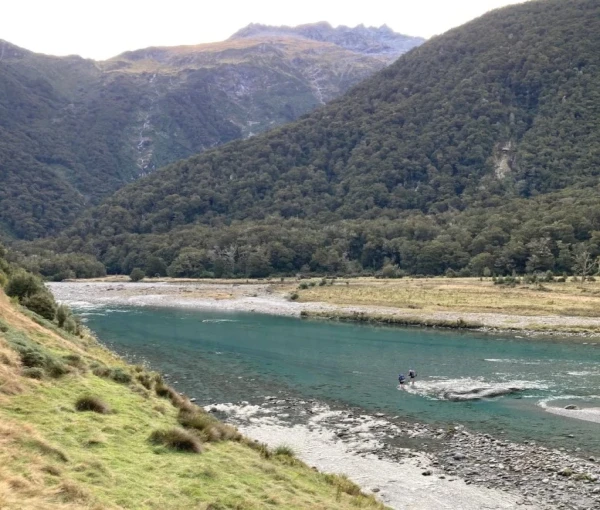River Safety: A Lesson in the Power of Mutual Support
River crossing skills are vital for all New Zealand trampers. Jeff learnt that on the Gillespie Pass Circuit. He shares his story as a lesson for everyone.
I realised that by supporting each other using the mutual support method, I was no longer a mere 65 kg going against the current. Now, we were a collective 300 kg mass. It felt 20 times safer.– Jeff
A couple of years ago, Jeff organised to tramp the Gillespie Pass Circuit in Mount Aspiring National Park with three friends. The 56 km, 3–4 day adventure is an advanced track up the Young River valley with a steep climb over Gillespie Pass to the highest point of 1,600 m.
The track crosses the Makarora River as well as numerous streams, so solid river crossing skills are necessary. Despite having many years of tramping under their belt, Jeff and his friends lacked this knowledge and experience.
“I’ve had many years of tramping across New Zealand, and I’ve always got by without river crossing skills. I thought this track would be no different,” says Jeff.
To get across the Makarora River, the group organised a jetboat ride to the start of the Young Valley. However, they’d decided to break up the last day from Siberia Hut to Makaroa township – the longest day at 26 km – stopping at Keran Forks Hut for the night. The only challenge with that plan was crossing the Wilkin River twice to get to the hut and back to the track.
A major tributary of the Makarora River, the Wilkin is a wide, fast-flowing river at the best of times. Like all rivers in Aotearoa, it rises quickly after rain and is prone to flooding.
The group reached the Wilkin River in good time, so weren’t under pressure, but the hut was tantalisingly close on the other side. They discussed their options and decided the river looked safe enough to cross. Unaware of the mutual support method – the recommended and safest way for a group crossing – they went separately. About halfway across, Jeff, being the lightest of the group at about 65 kg, began to feel his feet lifting off the riverbed.
“We all got across safely, but I was a bit worried,” he says. “Once we reached the hut, we realised that if it rained overnight, it might not be safe to cross back again the next morning.”
Luckily for them, the Department of Conservation’s Intentions Book at the hut had information about river crossings, so they set about learning the mutual support method. It involves standing in tight formation side by side and placing your arms between the back and pack of the person next to you and grasping their hip belt.
“We were lucky the hut had river crossing instructions,” says Jeff. “I guess we’re not the only ones who headed off without the skills.”
With only light showers overnight, the river was relatively unchanged the next morning. They assessed the best place to cross, and chose the widest and slowest moving part of the river. Using the newly learnt mutual support method, they set off into the current. It was a lightbulb moment for Jeff.
"I couldn’t believe how much safer I felt. I realised that by supporting each other using the mutual support method, I was no longer a mere 65 kg going against the current. Now, we were a collective 300 kg mass. It felt 20 times safer," says Jeff.
The story had a positive outcome – the friends crossed the river without mishap and acquired essential river crossing skills in the process – but it could have gone differently. Jeff’s key learning? “I would say educate yourself as much as possible before you go. The more I know about rivers, the more respect I have for them.”
River-crossing lessons
Educate yourself as much as possible.
If you know the route has a river crossing, learn as much as you can before you go, including how to retreat using the caterpillar method, in case the crossing becomes unsafe. I wish I’d read more, watched MSC’s river crossing video and get some hands-on experience.
Always use the mutual support method.
The biggest learnings for me was the power of weight. If you’re a lightweight person like me, and there’s a strong current, you’re so much more vulnerable to going under than four people essentially supporting each other as one unit using the mutual support method.
Go with someone more experienced.
In our group of four, no one had river crossing experience, despite choosing a track with unbridged rivers. If we’d had someone who had river crossing experience, the trip would have been much safer.
Respect the power of rivers.
No river is safe. Get the skills and experience before attempting a crossing, and if in doubt, don’t cross.
Explore Our River Safety Resources
- River safety skills | Learn essential river crossing skills
- Know how to cross | Watch our river crossing safety video
- Get the training | Find a river crossing course
PHOTO CREDIT | Dylan Cheyne, Plan My Walk | Wilkin River, Mount Aspiring National Park, Otago
